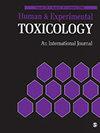与所有转录本功能相反的lncRNA APTR转录本NR 134251.1通过调控增殖和凋亡相关基因抑制增殖,诱导凋亡。
IF 2.7
4区 医学
Q3 TOXICOLOGY
引用次数: 0
摘要
砷暴露一直是全球数亿人关注的一个全球公共卫生问题。LncRNA APTR (alu介导的p21转录调节因子)在肿瘤的生长发育中起着至关重要的作用。然而,其在砷中毒反应中的作用尚不清楚。在本研究中,我们发现在亚砷酸钠(NaAsO2)处理的16HBE细胞中,APTR的所有转录本和转录本NR 134251.1的表达均呈剂量依赖性增加。沉默APTR转录物NR 134251.1抑制细胞增殖,诱导细胞凋亡。然而,沉默APTR的所有转录本对转录本NR 134251.1具有相反的功能。然后,我们检测了APTR转录物NR 134251.1沉默后增殖和凋亡相关基因的蛋白水平。结果表明,沉默APTR转录物NR 134251.1可上调转录因子E2F1的表达,调控其下游参与增殖和凋亡的基因,包括p53、phospho-p53-S392、phospho-p53-T55、p21、Cyclin D1、PUMA、Fas、Bim、BIK、Caspase-3、Caspase-7、Cyt-c。综上所述,砷诱导APTR表达,且APTR转录本NR 134251.1与所有转录本功能相反,为砷暴露的预防和治疗提供了理论依据。本文章由计算机程序翻译,如有差异,请以英文原文为准。
The transcript NR 134251.1 of lncRNA APTR with an opposite function to all transcripts inhibits proliferation and induces apoptosis by regulating proliferation and apoptosis-related genes.
Arsenic (As) exposure has been a global public health concern for hundreds of millions worldwide. LncRNA APTR (Alu-mediated p21 transcriptional regulator) plays an essential role in tumor growth and development. However, its function in arsenic-induced toxicological responses is still unknown. In this study, we found that the expressions of all transcripts and the transcript NR 134251.1 of APTR were increased in a dose-dependent manner in 16HBE cells treated with sodium arsenite (NaAsO2). Silencing the transcript NR 134251.1 of APTR inhibited cell proliferation and induced apoptosis. However, silencing all transcripts of APTR had the opposite function to the transcript NR 134251.1. Then we examined the protein level of the proliferation and apoptosis-related genes after silencing the transcript NR 134251.1 of APTR. The results showed that silencing the transcript NR 134251.1 of APTR up-regulated the expression of transcription factor E2F1 and regulated its downstream genes involved in proliferation and apoptosis, including p53, phospho-p53-S392, phospho-p53-T55, p21, Cyclin D1, PUMA, Fas, Bim, BIK, Caspase-3, Caspase-7, and Cyt-c. In conclusion, arsenic induced APTR expression and the transcript NR 134251.1 of APTR have an opposite function to all transcripts, providing a theoretical basis for the prevention and treatment of arsenic exposure.
求助全文
通过发布文献求助,成功后即可免费获取论文全文。
去求助
来源期刊
CiteScore
5.70
自引率
3.60%
发文量
128
审稿时长
2.3 months
期刊介绍:
Human and Experimental Toxicology (HET), an international peer reviewed journal, is dedicated to publishing preclinical and clinical original research papers and in-depth reviews that comprehensively cover studies of functional, biochemical and structural disorders in toxicology. The principal aim of the HET is to publish timely high impact hypothesis driven scholarly work with an international scope. The journal publishes on: Structural, functional, biochemical, and molecular effects of toxic agents; Studies that address mechanisms/modes of toxicity; Safety evaluation of novel chemical, biotechnologically-derived products, and nanomaterials for human health assessment including statistical and mechanism-based approaches; Novel methods or approaches to research on animal and human tissues (medical and veterinary patients) investigating functional, biochemical and structural disorder; in vitro techniques, particularly those supporting alternative methods

 求助内容:
求助内容: 应助结果提醒方式:
应助结果提醒方式:


